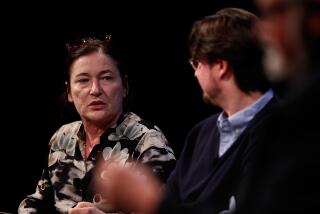Paperback Writers: Nightmare noir
William Lindsay Gresham’s novel “Nightmare Alley” (NYRB Classics: 288 pp., $16) tells the rise-and-fall story of Stan Carlisle, a hustling carnival wanna-be who transforms himself into the Great Stanton, a big-time stage magician, and then into a fake psychic, running a “spook racket” before reaching too far and engineering his own catastrophe.
In the end, Carlisle is torn apart by the very same emotional disturbances that have driven him, let down by a woman who loves him and betrayed by another who is even more ruthless than he. The “nightmare” of the title rings true, for this delirious and unstoppable novel -- first published in 1946, famously filmed starring Tyrone Power in 1947 and only now re-issued by NYRB Classics in its full, uncensored version with a new introduction by Nick Tosches -- inverts the American dream. The plot turns the Horatio Alger myth on its head and the psychology leans on Freud, but the torment, the pervading sense that the human creature lives in a trap he or she is doomed never to escape, comes from the heart and mind of the author. Never was noir more autobiographical than here.
“Baptized an Episcopalian, raised an agnostic, in turns a Unitarian, a hedonist, a stoic, a Communist, a self-made mystic, and an eclectic grabber after truth, I had at last come home,” wrote William Lindsay Gresham after his reconversion to the Christian faith in the early 1950s.
By then he was already middle-aged. Like Edgar Allan Poe, whose tortured life Gresham’s would in some ways recall, he’d been born in Baltimore; he’d scrambled through the Depression, working at odd jobs and contributing to the pulps; he’d served as a medic in the Spanish Civil War, fighting for the anti-Franco side, and his bad lungs had caused him to spend time in a tuberculosis ward; he’d attempted suicide, been through psychoanalysis, and was married (this was his second marriage) to the poet Joy Davidman; he’d spent years studying magic acts, freak shows, carnivals, and the lingo and confidence games often associated with them, research that led to his nonfiction book “Monster Midway” as well as his great novel. He was a scholar of the far-out (he wrote an introduction to Charles Williams’ “The Greater Trumps,” a novel about the quest for the original Tarot deck, the gypsy cards around which Gresham structured “Nightmare Alley”) and a writer who saw poetry where others dared not to look.
“Dust when it was dry. Mud when it was rainy. Swearing, steaming, sweating, scheming, bribing, bribing, bellowing, cheating, the carny went its way. It came like a pillar of fire by night, bringing excitement and new things into the drowsy towns,” Gresham writes in “Nightmare Alley.” “Then it vanished in the night, leaving the trodden grass of the field and the debris of the popcorn boxes and rusting ice-cream spoons to show where it had been.”
Gresham distills a microcosm of life into the carnival. He pictures an entire world and explores it. To his hero, however, he gives a different agenda, and in the terrific opening scene Stan Carlisle learns what turns a man into a “geek” (it was this novel that sent the word into common cultural parlance), the lowest of the low, a performer who swallows snakes and bites the heads off live chickens. Stan imbibes the lesson that will empower him:
“The geek was made by fear. He was afraid of sobering up and getting the horrors. But what made him a drunk? Fear. Find out what they are afraid of and sell it back to them. That’s the key. The key!”
Stan takes this as his guiding principle, rising higher and higher, until he meets someone who will work the same process on him, “Dr Lilith Ritter, Consulting Psychologist,” maybe the scariest femme fatale in the entire noir canon, and certainly the smartest. “The brain held him; it dosed him with grains of wild joy, measured out in milligrams of words, the turn of her mouth corner, one single, lustful flash from the gray eyes before the scales of secrecy came over them again. The brain seemed always present, always hooked to his own by an invisible gold wire, thinner than spider’s silk. It sent its charges into his mind. . . . “
Before long Stan is on his knees before Lilith, spilling the guts of his twisted childhood, licking her feet and painting her toes, a scene that Vladimir Nabokov echoed in “Lolita” and that turned the stomach of novelist Walter Kirn when he wrote about “Nightmare Alley” some years back.
Gresham was a whack-job, no getting around it. That reconversion to Christianity didn’t stick and neither did his marriage to Davidman. He smashed chairs, was unfaithful, wept in public and fired rifles through ceilings to relieve his temper. He broke a bottle over the head of one of his sons. Davidman divorced him and 1954 and resettled in England. There she targeted C.S. Lewis (with whom both she and Gresham had corresponded) and eventually married him, turning the author of the Narnia saga (later books in the series are dedicated to the Gresham boys) into the hero of one of the 20th century’s unlikeliest love stories.
Gresham married again but published little through the rest of the 1950s. He studied Zen Buddhism and even L. Ron Hubbard’s “Dianetics.” He was restless, endlessly seeking, never quite finding, an addictive personality always on the edge of disintegration. “Nightmare Alley” remains a masterpiece, not only due to its driving narrative power, but because it’s underpinned by the premise that the human animal is alone, helpless in the face of destiny, stumbling in the dark, down the nightmare alley toward the inevitable wall of death at the end. Yet we can’t stop ourselves hoping, and fearing, that there might be something beyond that wall. The message of this disquieting book couldn’t be more human, yet that message is metaphysical rather than moral.
Gresham reached the end of his own alley on Sept. 14, 1962. He’d recently published an excellent, and successful, biography of Houdini, and producers were trying to turn it into a musical. Outward signs suggested that a career was on the rise again, but Gresham’s grasp of himself was fallible, and there were big problems. Suffering from cancer of the tongue, still an alcoholic, still grieving the death of Davidman (she died in 1960, after her own long struggle against cancer), knowing that C.S. Lewis was doing a better job of providing for his sons than he could, Gresham checked into the Dixie Hotel in Times Square and swallowed a lot of pills. “Man Said to Be Author Is Found Dead in Hotel,” said a report in the next day’s New York Times.
Gresham, one of life’s savage and self-destructive ironists, would have appreciated that “said to be.”
Rayner is the author of numerous books, including “A Bright and Guilty Place.” Paperback Writers appears at latimes.com/books.
More to Read
The biggest entertainment stories
Get our big stories about Hollywood, film, television, music, arts, culture and more right in your inbox as soon as they publish.
You may occasionally receive promotional content from the Los Angeles Times.






